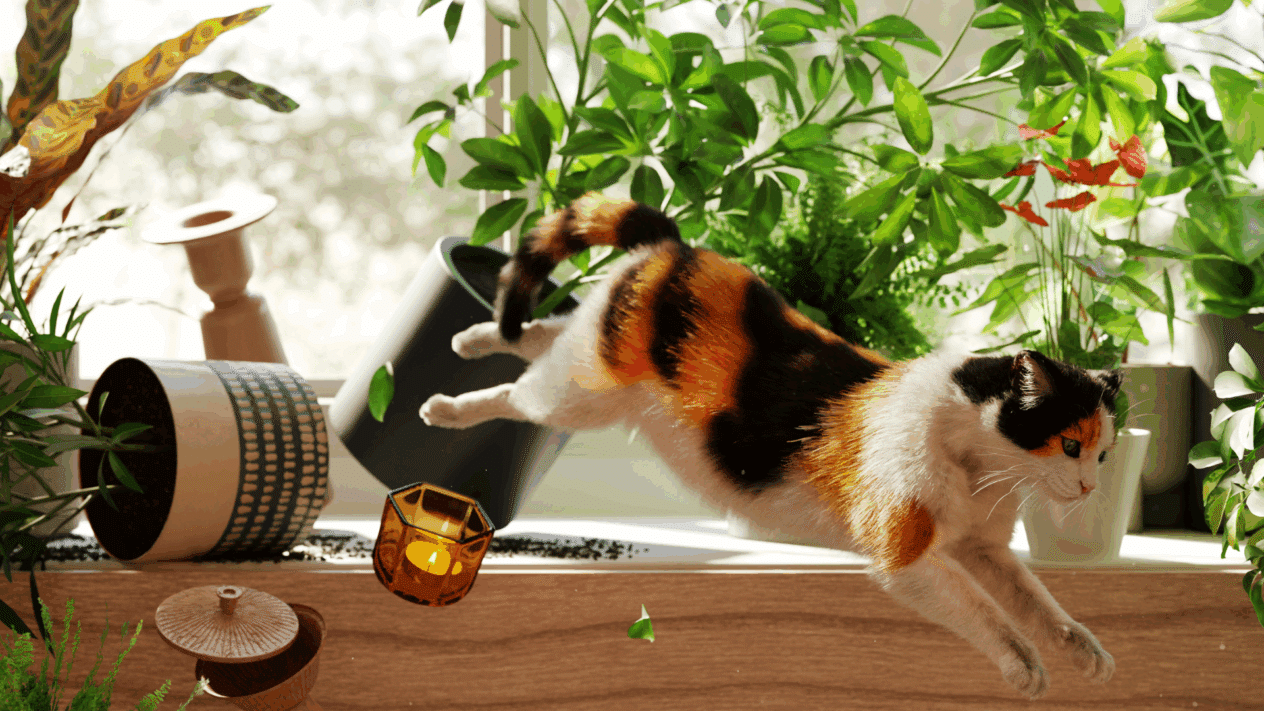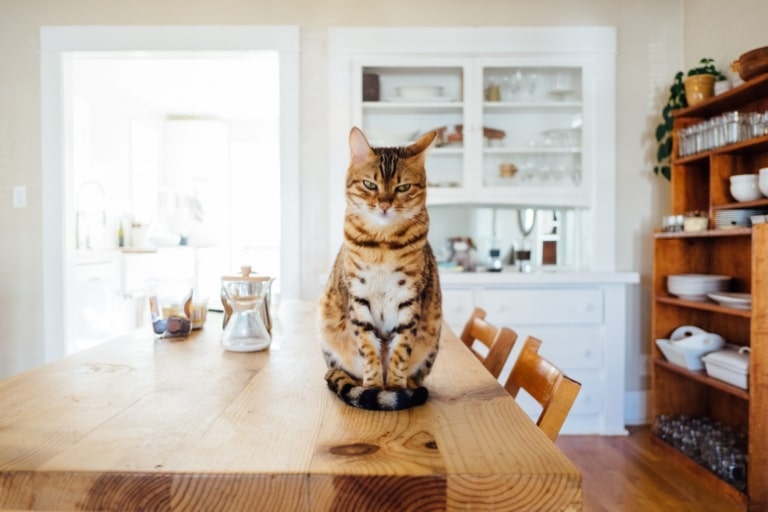Probably, there is no cat or cat that at least once did not climb the curtains or explore the owner’s table. But not every pet owner knows how to wean him from bad habits. In fact, it is not difficult and there are a few tricks, thanks to which the cat will realize that it is not necessary to do so, and will leave the curtains or table alone.
First, let’s talk about how to teach cats to get rid of the habit of climbing on the curtains

Everyone knows that the conquest of vertical surfaces is an inherent habit of cats. And they don’t really care if it’s a tree trunk, or if it’s your brand new expensive curtains. So here are some expert-approved ways to keep your curtains safe from cat claws:
- Find something for the cat to do. To prevent your pet from wanting to climb the curtains because of excess energy, make sure he has something to play with and a special place to scratch his claws and play interesting games with the owner.
- Offer the cat an alternative. Animals need to climb, scramble and jump, it is a natural need for each of them, regardless of their energy level. So, to ensure that the cat doesn’t choose the curtains for this, offer him other vertical surfaces, such as a scratching post or play set. You can choose different variants of such constructions in zoological stores, or you can relieve yourself from improvised materials.
- Place the cat stand near the window. In addition to the fact that your pet loves to spend time actively, he also loves to sit and watch various objects through the window. Therefore, if possible, we advise you to place a special design for the cat near the window. This will save the curtains and satisfy the cat’s curiosity.
- Use citrus scent. The scent of citrus always works without fail because cats dislike this particular odor. So, try placing fresh orange, lemon or tangerine peels near the curtains. You can also apply a citrus air spray or a few drops of essential citrus oil. Before using this particular method, make sure that your pet is not allergic to the citrus scent and that the products you choose are one hundred percent safe for cats.
- Create physical obstacles for the cat. In this case, tying the curtains, aluminum foil, or a motion detector will help keep them away from the animal’s claws. Tie the curtains or use special magnetized curtain catches. In this way you will limit the surface on which the cat can climb upstairs. Apply aluminum foil: cover the floor under the curtains with it and the cat will be afraid to approach them because this particular pet hates the sound of foil and touching it. If, all of a sudden, on your cat does not work the above methods, use a special device that produces sounds of high frequency. This is a motion detector, its sounds are not audible to human ears, but scare away cats and make them turn around and run in the opposite direction from the curtains. Once your Ponytail forgets his habit of climbing the curtains, these obstacles can be removed.
- Teach your cat the rules. If you catch your cat or cats climbing the curtains, sternly say “No!” and clap your hands lightly. Pets are sensitive to such sounds and will very quickly realize that it is their behavior that is unwanted by the owner. However, do not use methods that can cause fear in your Pet – this can exacerbate the problem. After all, if the animal is punished in some way, splashing it with water from a sprayer, knocking a newspaper on some surface or shouting, it may stop doing harm, but it will also begin to distrust the owner.
We hope that the tips we have presented will really help you to permanently wean your Pet from climbing on the curtains. And we move on to the recommendations that can dissuade a cat or a cat from the bad habit of climbing on the table.

Let’s discuss some tactics for dealing with the cat’s habit of climbing on tables
First of all, let’s understand why the cat or cat climbs on the table. If the animal is trying to get something edible in this way, then you need to teach it to beg for food, and the problem will solve itself. Also, cats can use the table as a point of observation or a place where they can just be in peace and quiet. In this case, you need to offer them an alternative – a stand, shelf, their own house or other surface with an excellent view of the territory. In other cases, in order to form indifference to the surface of the table or at least make the forbidden place not so attractive, we suggest using our advice:
- Spread aluminum foil on the table surface. Once again, aluminum foil comes to our aid, which can scare the cat with its rustling. Your pet definitely hates the sound and texture of foil, so leave it on the table and wait for the cat to jump on it. The animal is sure to return to the floor instantly, and you leave the foil on the table for a few days to allow the cat’s new habit to take hold.
- Place a low vessel of water on the surface of the table. Most cat breeds are afraid of getting their paws wet. Therefore, a plastic tray of water on the table will deter those favorites that do not like water procedures.
- Apply a citrus scent to the surface of the table. We noted above that it is cats and cats that do not like citrus scents. Therefore, in order for the animal to stop liking the table surface, either spread fresh citrus peels on it, or rub the table area with essential citrus oil. The same applies to the smell of eucalyptus. By the way, you can also pour the oil into an aroma lamp and leave it on the table. Your pet will definitely try to avoid the unpleasant odor in every possible way and simply will not come to the table.
- Stick strips of double-sided scotch tape on the table surface. After stepping a few times with the pads of his paws on something sticky, the next time the cat will think twice about whether he should jump on the table. In addition, on his paws will remain a sticky base, which he will have to lick for a very long time. But we want to note that this method is better not to use if your cat is long-haired, because the sticky base is almost impossible to comb out of his fur, so you will only have to trim it. And if your animal is fearful, it is also not worth applying sticky tape. Because once trapped, the pet can get very frightened and this will only add to his stress.
- Praise the cat for good behavior. This method is very delicate, because it requires constant attention and a lot of patience from the owner. His task is to constantly praise and reward the animal for good behavior. The sequence of actions is as follows: if you see that the cat is going to jump on the table, you need to attract his attention with a toy or some fun and treat something tasty. Of course, this method will not work immediately, but after a few weeks the cat will definitely have positive associations with the praise of the owner and will forget about the table.
- Remove food from the kitchen table. You should always remove all food items from the table. Then the cat will make sure that there are no attractive objects on the surface and, most likely, will recognize this object as uninteresting to him. So you can solve two problems at once: first, your pet will stop climbing on the dining table, and secondly, will not pull food from it.
So, remember that the habit of cats to climb on tables and other surfaces, where the pet does not belong, is just a manifestation of natural curiosity and a feature of behavior. Because, on high planes cats feel safe and explore the world around them. This habit of the pet is very easy to correct, while remembering the main rules:
- The animal is not able to understand the connection between misbehavior and punishment, so do not punish or intimidate the Kotik for pranks. Perhaps he will stop climbing where he is not allowed, but he will start treating you differently, stop trusting and even start being afraid.
- In the process of correcting undesirable behavior of the cat , use only those tools and special devices that will not harm him.
- It is much easier to retrain a kitten than an adult cat or cat. Therefore, you need to be patient, because it may take from several days to several weeks to get rid of your cat’s bad habit.
We wish you success in such a delicate matter and hope that our advice will be useful for owners of kittens, cats and cats, improve everyone’s life and add bright and unforgettable moments!









